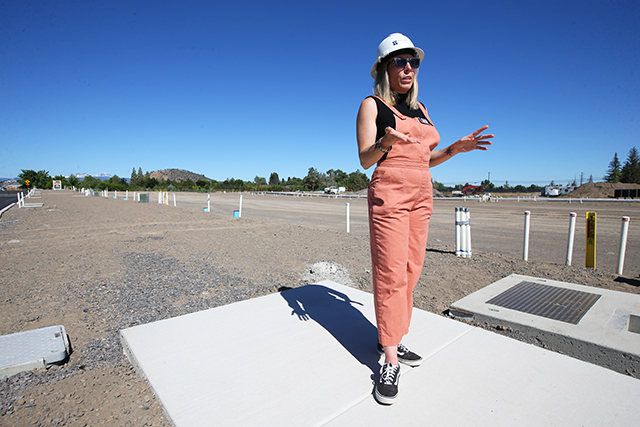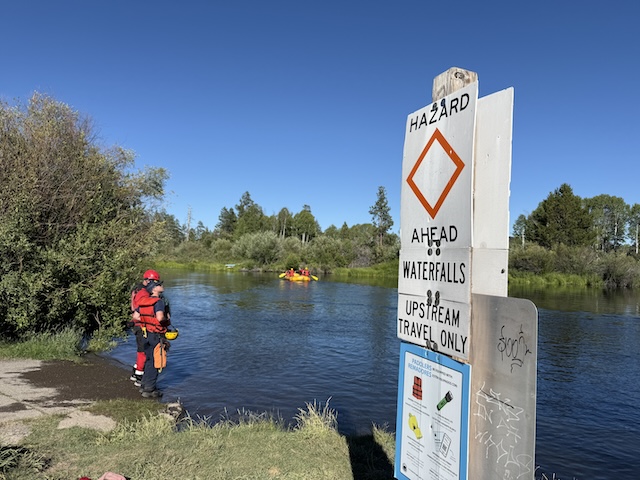Bend land use experiment finally results in lower-cost homes
Published 8:00 am Sunday, July 20, 2025

- Jenn Kovitz, community engagement person for Hayden Homes, shows a 37 acre site being prepared for the development of about 350 units which will be built, just east of Bend off of U.S. Highway 20, during a tour of the area Monday morning. 7-14-25 Andy Tullis/The Bulletin
Test UGB expansion offers affordability, but raises long-term land policy questions
Nine years ago, state lawmakers set up a test.
The question was whether giving slack for rules around a pillar of Oregon’s land use system — the urban growth boundary — could provide a new tool for creating affordable housing.
Bend is at the epicenter of that experiment. And results are beginning to emerge.
Trending
Just south of U.S. Highway 20 on the eastern edge of Bend, developer Hayden Homes has begun clearing land in the first phase of a 350-home development catering largely to middle-income people. Building on those 37 acres is only possible because of special legislation from 2016 circumventing urban growth boundary rules.
Since then, Bend has been allowed several other one-off land additions in exchange for affordable housing.
As the city continues to face pressures of housing and growth, the question is whether the exceptions to the rule will become the norm — or whether other types of tweaks are needed.
“I believe in the land-use system, but we have to be honest with ourselves about the impacts that it has,” state Sen. Anthony Broadman, D-Bend, said in an interview. “We have to constantly be ensuring that it is accomplishing what Oregonians want. That is employment lands, housing and preventing sprawl.”
Single-family, three-bedroom, 1,400 square-foot homes at Parkside Place, the new Hayden Homes development, are starting at $475,000. That’s two thirds of the city’s median home price of $693,000, which has fallen in recent months. In the past 12 months in Bend, fewer than 100 homes sold for less than $500,000 while more than 400 have sold for $1 million or more, according to the Beacon Report, a real estate publication.
The development’s most affordable rental units will be built first, with more than 100 coming in the first phase restricted to people earning less than 80% of the area median income, or $64,000 for an individual. In total, 40% of the housing at Parkside Place will be restricted to that income level, more than the 30% required by HB4079, the 2016 bill creating the pilot project.
Trending
It took nearly a decade to break ground partially because a previous developer pulled out of the project in 2020. It also took heavy collaboration between Hayden Homes, the city, and several other agencies.
The development has been highly touted. Brett Swanson, regional director with Hayden Homes, said in a recent press release that the development “has achieved a level of affordability for Central Oregon families that is almost unheard of in our community today.” In 2023, when plans were approved, Bend’s former housing director Lynne McConnell said what Hayden Homes was attempting to do — build affordable housing without a subsidy — was “nearly impossible” given high land and infrastructure costs.

Construction under way at the Hayden Homes 37-acre site for development on the eastern edge of Bend, where about 350 units will be built, just east of Bend off of U.S. Highway 20. Andy Tullis/The Bulletin
Although the project has not received any formal subsidies from federal housing programs, it did receive cost assistance from Deschutes County and the city of Bend in the form of federal grants and breaks on system development charges, which are fees charged for infrastructure.
The project would not have been possible without a discount on the land itself.
Landowners sold it to Hayden Homes for less than it would have been worth otherwise, according to Deb Flagan, vice president of community engagement for the company. During a typical urban growth boundary expansion, which can sometimes take decades, cities are only allowed to bring in land necessary to accommodate economic and housing needs for the next 20 years. The supply of buildable lands is limited.
“As soon as that land is in the UGB, it is gold,” Flagan said.
Bend’s last urban growth boundary expansion was approved in 2016 and added 2,180 acres of land to the city. But the 37-acre parcel south of the highway was left out. It would still be sitting vacant if not for the pilot project legislation. That made landowners more willing to negotiate, Flagan said.
Down payment on growth
Oregon’s signature land use laws were set up more than 50 years ago, and it’s still one of the few states with such restrictive measures for how and where cities can grow outward. Critics say the system is a culprit for the high cost of land and housing, while proponents say it makes cities more livable and protects natural open spaces and farmland.
As bureaucratic and time-consuming the growth boundary expansion process may be, cities have consistently added thousands of acres of land in the past 10 years, said Gordon Howard, a manager who works with cities on urban growth boundary expansions at the state’s Department of Land Conservation and Development.
“I think the record of success there in the past 10 years … is the sign that we’re doing something right in the existing system.”
One-time expansions deviate from the typical urban growth boundary process because cities can bypass the extensive and time-consuming analysis required to show whether the expansion is needed to meet future land needs.
Some policymakers in Bend say they view the tool as a down payment on future growth.
Bend’s long-term planners are just beginning to craft the city’s next 20-year growth plan, which will determine how many future residents can live on lands already inside the city, and how much more land is needed to accommodate the rest.
Portland State University predicts the city will add another 50,000 residents in the next 25 years. The state estimates Bend will need to build 33,000 homes across all income levels.
Bend’s three land additions in the past 10 years have added nearly 400 acres to the city outside of the traditional land use system. That supply will take notable bites out of those beefy housing goals. Lawmakers have designed expansion bills with affordability requirements — which isn’t a guarantee during a typical expansion.
Brian Rankin, the city’s chief long-term planner, estimates the one-off expansion areas will provide 15% of the city’s two-decade housing need for income levels between $48,000 and $64,000, and about one-fifth of the units needed that aren’t income restricted.
“A common refrain and a criticism is, ‘this is violating the spirit of Oregon planning,’” Rankin said. “In some ways, you could look at it that way. Or you could look at it as, it’s actually pretty close, it’s just designed to be faster.”
“Whichever perspective you have, I think you could find a little bit of truth in both of them,” he said.
Testing the waters
Urban growth boundaries have created a permanent land shortage for cities, said John Charles, president of the free-market think tank Cascade Policy Institute. He called one-time expansions a “policy procrastination” for a “terminally dysfunctional” land use system.
“Policy makers need the courage to confront this problem,” he said in an email.
The intensifying issue of housing affordability has pushed lawmakers to try new strategies. But they have not yet taken the full plunge. Knute Buehler, the former state representative from Bend who introduced the 2016 pilot project, said he wanted to first test out the concept of an expedited land addition before applying it across the state. Bend and Redmond were the only cities to apply for the program, and both were eventually accepted.
In 2021, Rep. Jason Kropf, D-Bend, led a bill to add 260 acres to Bend’s southeast side — enough for 2,500 housing units — called the Stevens Road Tract. In 2024, a bill introduced by Gov. Tina Kotek made a one-time 100-acre urban growth boundary expansion available to cities across the state. Bend was the first city in the state to use the tool, choosing a 90-acre site off of Knott Road for a fast-tracked expansion.

Broadman, the state senator from Bend, supported each of the expansions as a member of the Bend City Council. All have required developers to build a certain percentage of affordable units.
“I don’t think there’s a blanket rule that these types of land use actions are always good or always bad,” Broadman said. “We need to use opportunities to make sure everyone in Bend has a place to live and people who work in Deschutes County can afford to live here.”
Growing up, not out
Meanwhile, land use advocacy groups like Central Oregon LandWatch have fought against each of the one-time expansions, which they view as unnecessary and a step toward urban sprawl.
“We’re starving resources away from our urban core and putting them out in places that need every stitch of infrastructure provided,” said LandWatch Executive Director Ben Gordon. “So it is arguably one of the most expensive ways and least efficient ways of providing housing.”
Instead, advocates argue Bend should drive harder at a core principle of the land use system: efficient land use. Some of that is already occurring as the city has already awarded nearly $100 million in property tax rebates to developers of multifamily apartment buildings inside the urban growth boundary with a certain percentage of affordable units.
The three -, four-, five- and six-story apartment buildings that the city is facilitating through the tax program provide eight times as many units per acre of land than the Parkside Place development at the edge of town, according to Kristin Reidelberger, a program manager for LandWatch. The idea is that preserves open space outside the city, and means people don’t have to travel as far to get to work, school or elsewhere.
Michael Andersen, a policy analyst with the sustainability think tank Sightline Institute, said the group tends to think one-off urban growth boundary expansions aren’t a good idea. But the fact that there is political pressure to add land to cities is a sign of a larger problem.
“If the land supply is inadequate for some cities to achieve their housing goals and the land use system is failing to keep up with those needs, then we should try to fix the systemic problems with the land use system rather than using a series of band-aids,” Andersen said in an email.









